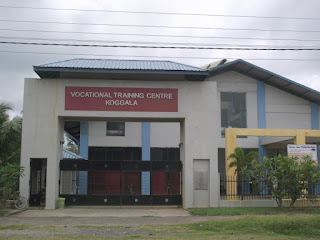



The Schools Project Observation
School Name: Kogalla Vocational Training School
Director: Sarath Meddadoda
garmentschool@hotmail.com
Enrollment: 233 students- men: 166; women: 67 Ages: 16-30 years
After having the opportunity to visit some traditional educational facilities in Sri Lanka and doing background research into the state of education in the country, I became extremely interested in the "non traditional" paths to higher education that are available to Sri Lankan students. The government has launched, in the last number of years, a special vocational-training program for students who are not able to attend university. As I have seen, the numbers of students who cannot further their educations at the traditional university level in Sri Lanka is extremely high, leaving many young adults with few options after graduating from high school. Thus, the government has been working to address this critical need for the youth with its technical/vocational training schools. The school is under the auspices of the Vocational Training Authority of Sri Lanka. The guiding principal of the school is to give the students who are not able to attend university another path to success in life. The school building that I visited in Kogalla was relatively new and modern, built about 4 years ago by the central government under its new directive. These schools are spreading everywhere in the country. I was able to travel out to Kogalla, located on the outskirts of Galle District, in Southern Sri Lanka, and talk to the Director, Sarath Meddadoda, as well as get a tour of the facility.
Mission of the School:
The main areas in this particular school include garment manufacturing and electrical training. There are 8 courses offered in this areas. The main courses are machine operating, fabric cutting, inspection, quality control, curtain make,r production supervisor, industrial machine mechanic. The school is about two years old, and was built with the help of USAID, who provided the building and the machines located in the school. The instructors come from both the private and public sectors.
Critical Resources Missing:
According to the Director, the school wants to start a production unit for garments if there was additional resources that could be procured. With a production unit, this would allow for more hands on instruction with the other courses. He desires more practical training for the students. Currently, the students must go to local garment factories for on the job training; He wants to make this all in-house. Making this a reality would mean covering the running costs of the production line; the machinery and labor is all in place, but the materials and sourcing would need to be capitalized.
Most successful training area:
According to the Director, the work study officer program has been the most successful program for the school, because this is, "A very essential area for the growing Sri Lanka garment sector."
Where do you see the school in five years?
" In five years, the school will have a strong production unit. The school will be taking orders and doing exporting of products and be able to send students abroad and provide international training in these areas." The director continued about his future goals, "we would also like to expand the electrical area, into industrial wiring and house wiring for the students."
Programs for the poor students?
According to Mr. Meddadoda, the government is responsible for all of the operating expenses of the school. Some of the courses cost money for the students., and other courses actually pay the students up to 600 rupees per month-these are in high needs areas. However, in all of the areas, if the students are economically disadvantaged, the school will cover their expenses and actually give them a salary. All of the courses will give a 20% reduction in the cost to high needs students-the government provides these funds.
